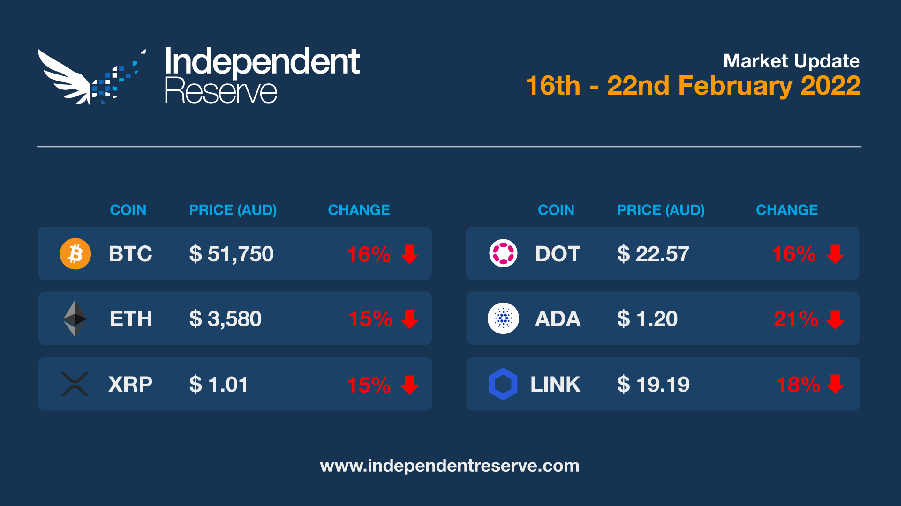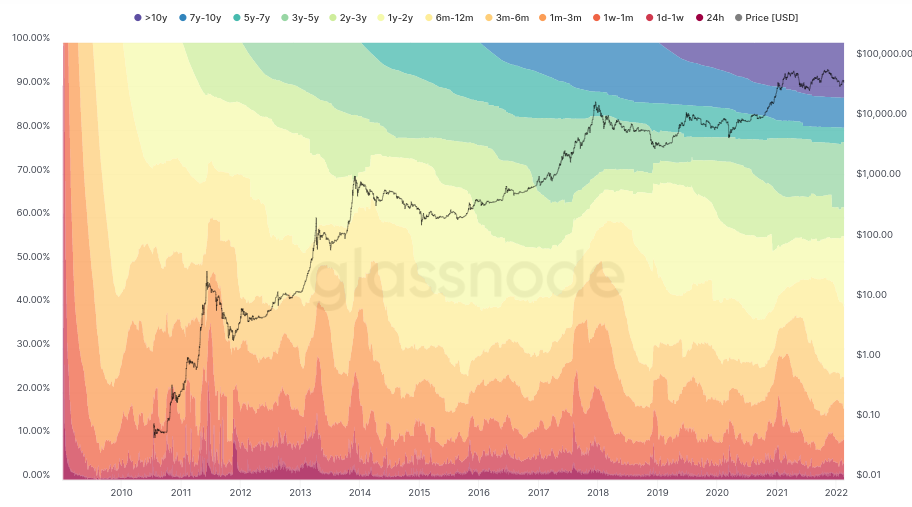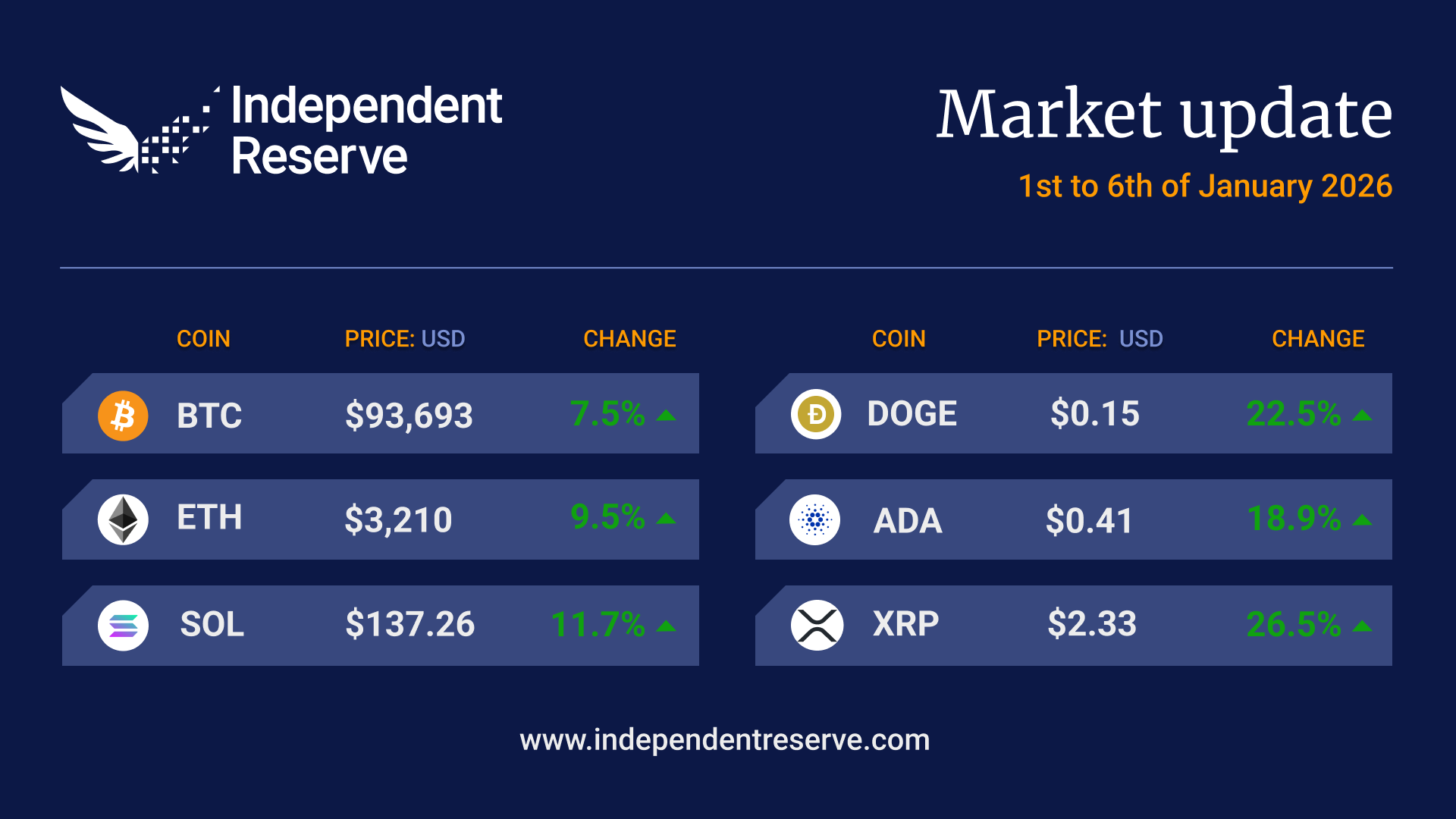In Markets
The year started with a US$2.21 trillion (AU$3.1T) crypto market cap but it’s declined 25% since and hit US$1.69 trillion (AU$2.35T) as of today. The threat of regulatory clampdowns and the possibility of war with Ukraine is weighing heavily on markets. Bitcoin fell below the US$37K (AU$51.5K) mark earlier today and the Fear and Greed Index is at 25 or Extreme Fear. At the time of writing, Bitcoin is at AU$51.7K for a 16% loss this week. Ethereum lost 15% to trade just below AU$3,600, XRP fell 15% and Polkadot lost 16%. Activity on the Bitcoin network has fallen back to mid-2019 levels, from 400K daily entities transacting in November down to around 275K today “indicative of tepid demand from new users,” Glassnode commented. In more positive news, El Salvador’s GDP soared by 10.3% in 2021 for the first time, showing that at the very least the Bitcoin Law didn’t tank its economy.

From the IR OTC Desk
Economic data this week has taken a back seat to Russia/Ukraine headlines, which have been driving sentiment and price action. In Australia, the unemployment rate (Jan) was maintained at 4.2%, while the participation rate (Jan) increased from 66.1% to 66.2%. This corresponded to an employment change (Jan) of +12.9k. While there has been much central bank communication in the weeks following Australia’s CPI release at the end of January, we await the Reserve Bank of Australia’s Board meeting on the 1st March for additional information on the monetary policy tightening cycle.
In the US, retail sales MoM (Jan) rebounded sharply to +3.8% versus a market consensus of 2%. Federal Reserve members continue to vocalise their opinions on the current state of monetary policy, as the divergence of thought continues on the subject. Expect more of this to continue into the next Federal Open Market Committee meeting, scheduled for the 16th March. Of note will be any broad agreement on whether the Fed will remain open to a 50bp increase in the underlying Fed Funds rate. Critical to the Fed’s assessment of inflation will be this week’s Personal Consumption and Expenditure Price Index (PCE) (scheduled for release on 26th February). As per last week’s publication, interest rate policy updates and any change to the Russian/Ukraine foreign relationship will continue to prove key.
On the OTC desk, risk reduction has been a key theme, as cryptocurrencies correlated in varying significance with risk assets, and their gyrations with Russia/Ukraine headlines. Last week we highlighted that the correlation between BTC and US tech stocks appears to have broken down: this has again flipped, with all risk assets in general tracking in very similar directions. From a flow perspective, we have seen strong demand in stablecoins – most notably USDT, USDC and DAI. This lends to the larger theme of de-risking in the market. Interestingly, USDT has moved closer to its 1:1 ratio with USD, trading 2-4% above par at the time of writing. At the end of last week there was a near 8% premium in the wholesale market for USDT/USD as a trading pair. Continue to expect both global macro and Russia/Ukraine headlines to drive short-dated volatility and market direction.
For any trading needs, please don’t hesitate to get in touch.
In Headlines
Regulatory roundup
The US Government is getting serious on crypto: The FBI has announced a new crypto crimes division (the Virtual Asset Exploitation Unit), the Department of Justice has unveiled the first director for the National Cryptocurrency Enforcement Team and President Joe Biden is expected to issue an executive order soon directing relevant government agencies to study crypto with the aim of beefing up laws. As a sign they are serious, crypto lending and borrowing platform BlockFi has just agreed to pay $50M (A$69.6M) penalty to the SEC and another $50M to 32 US states that took action against it for offering illegal securities.
Cold weather ahead?
While some believe the four-year Bitcoin halving price cycles are a thing of the past, others believe we’ve entered the back half of the cycle (the bad bit). Du Jun, co founder of Huobi commented: “If this circle continues, we are now at the early stage of a bear market. Following this cycle, it won’t be until the end of 2024 to the beginning of 2025 that we can welcome the next bull market on Bitcoin.” But is the current price action related to the halving? As an unnamed billionaire told Insider this week frothy valuations for meme stocks, tech stocks, crypto and SPACs were all symptoms of irrational exuberance that is finally meeting reality: “We really did hit peak stupid, but peak stupid extended beyond truly, truly stupid and then we went to bottom-of-the-ocean-rare-earth-metal-companies stupid.” Meanwhile Ethereum cofounder Vitalik Buterin says another ‘Crypto Winter’ could be a good thing by clearing out the “speculative attention”. “The winters are the time when a lot of those applications fall away and you can see which projects are actually long-term sustainable, like both in their models and in their teams and their people.”
Ukraine and Russia
At the same time they’re preparing for war, Ukraine and Russia are getting serious about crypto. The Ukrainian Parliament has passed the Virtual Assets Law by an overwhelming majority, legalising crypto and crypto exchanges. The Bank of Russia has announced that initial testing of a CBDC has been successful and new (draft) crypto regulations in the country would keep crypto illegal as a means of payment, but would allow investors who can pass an online exam to invest in it.
Big Brother and the banks
The Canadian Government has passed the ‘Emergencies Act’ and has been closing bank accounts of anyone involved with the “Freedom Convoy” protesters. The extraordinary measures will need to survive a coming legal challenge by Alberta Premier Jason Kenney who believes provisions that were designed to stop terrorists are being misused by the Trudeau Government to harass “people whose opinions they disagree with.” The Ontario Securities Commission actually reported tweets to the police by the CEOs of Coinbase and Kraken that were critical of the moves. Nunchuk, a self-custodial Bitcoin wallet, was ordered by a Canadian court to freeze and report any users or transactions involved with the convoy. It responded it couldn’t because that’s now how BTC works. While Bitcoin has a role to play, there is considerable debate as to whether crypto provides a realistic alternative to avoiding the measures, as in this piece by Craft Ventures VC David Sachs.
60% of BTC supply unspent in a year or more
According to Glassnode on-chain analytics, 60% of BTC supply has remained unspent for at least a year. Despite volatility present in the markets, this data reinforces that few long-term holders are interested in selling. Only twice before has the quantity of available supply been so notably stationary in wallets. CIO of Atlanta Digital Currency Fund, Alistair Milne, recalls that both occasions followed a downtrend and preceded a “huge bull move” in Bitcoin price action.

Bitcoin HODL Waves chart | Source: Glassnode
More on HODLers
Glassnode says the current BTC price action is being driven almost entirely by short term traders and that the realised cap HODL waves metric shows that, “Long-term holders are more or less hanging onto their coins and not doing a great deal with them.” CEO of Three Arrow capital, Zhu Su, commented: “One reason onchain data is showing impressive holding behavior is bc many ppl actually did buy $BTC in 2017/2018 only to sell for a loss after losing patience. Anecdotally many of these ppl are staying humble this time and buying every month regardless of what else is happening.” Glassnode said the time to worry will be “if we see [the realised cap HODL waves metric] start to climb again, which shows that old coins are being spent and that means that there’s a loss of conviction in some of those longer-term holders.”
A reason to be cheerful
Pantera Capital Co-CIO Joey Krug believes that traditional markets and crypto markets went down in tandem due to the looming threat of multiple interest rate rises … but that the news has been priced in. Krug notes that crypto’s correlation with traditional markets after such an event historically only lasts about 70 days before breaking down. “And so we think over the next number of weeks, crypto is basically going to decouple from traditional markets and begin to trade on its own again,” Krug said, pointing out that even a 1.25% increase in interest rates “doesn’t make a huge, huge difference for something that’s growing four to five times year over year.”
JPMorgan is the first bank into the metaverse
Banking juggernaut, JPMorgan has become the first lender to set up shop in the metaverse. The unveiling of the bank’s ‘Onyx lounge’ in the blockchain virtual world, Decentraland, has once again shown how extraordinary recent advances into the metaverse have been. JPMorgan has also released a white paper on how businesses can find opportunities in the metaverse predicting that the metaverse would soon generate US$1T (AU$1.39T) in annual revenue. The bank now joins the likes of electronic giant Samsung, opening up a virtual store, Manchester United, and their collaboration with Sony to build the first virtual soccer stadium and the country of Barbados, establishing a metaverse embassy.

JPMorgan’s Onyx lounge in Decentraland. (CoinDesk screenshot)
Until next week, happy trading!


